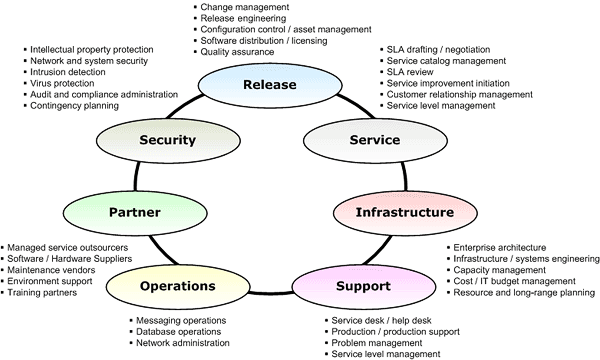Experience has shown that, to be successful, IT management teams must achieve numerous quality goals associated with key service functions. The role clusters of the Microsoft Operations Framework (MOF) Team Model are organized around seven general categories of activities and processes, each with its own set of quality goals. Role descriptions within a cluster are focused specifically on activities directed to meet the quality goals; they are not job descriptions, and they do not imply any kind of corporate organization.
The following figure maps the seven role clusters to two dozen possible functional roles or function teams in a typical operations organization. The rest of this section summarizes the functions of each of the seven role clusters.

Role Cluster Details
Descriptions for each of the role clusters are provided in the following table.
Table: Role Cluster Descriptions
| Role cluster | Description |
|---|---|
|
Release |
Tracks changes and lessons learned in a corporate knowledge
base. |
|
Infrastructure |
Defines physical environment standards. Manages physical
assets. |
|
Support |
Provides technical support for internal and external customers,
resolving incidents and problems using highly automated tools and
knowledge base systems. |
|
Operations |
Ensures that daily, routine tasks are performed reliably within
specific technology areas and production systems (for example,
messaging and system administration). |
|
Partner |
Defines and manages partnerships in a mutually beneficial and
cost-effective manner. |
|
Security |
Ensures data confidentiality, data integrity, and data
availability. |
|
Service |
Ensures that all of the IT services being provided to customers
are aligned to the customers' need for them. |